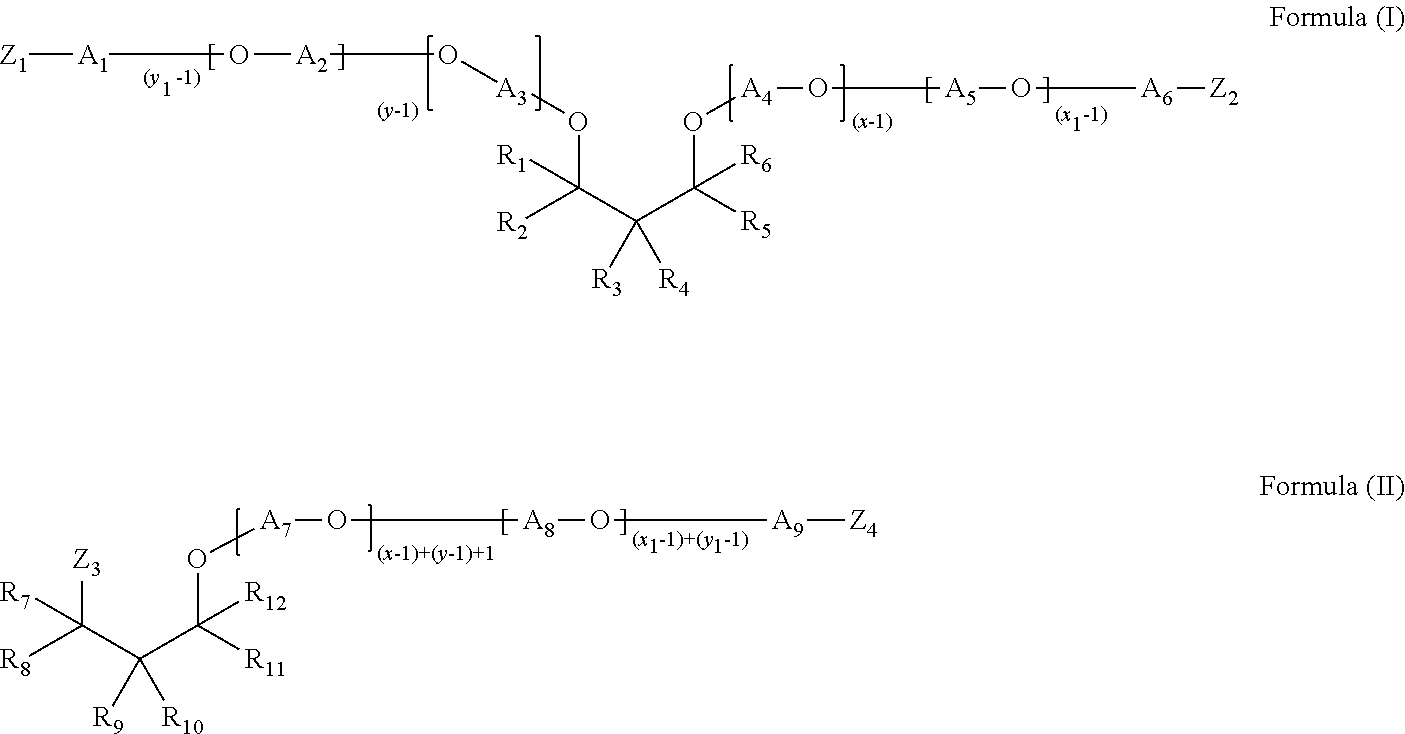Liquid laundry detergent composition
a technology of laundry detergent and composition, which is applied in the preparation of detergent mixture composition, detergent compounding agent, liquid soap, etc., can solve the problems of laundry detergents and inability to achieve satisfactory cleaning at cold temperatures
- Summary
- Abstract
- Description
- Claims
- Application Information
AI Technical Summary
Benefits of technology
Problems solved by technology
Method used
Image
Examples
examples
[0081]In the following examples, the individual ingredients within the cleaning compositions are expressed as percentages by weight of the cleaning compositions.
synthesis examples
Example 1
1 mol 2-Butyl-2-ethyl-1,3-propane diol+4 mol propylene oxide / OH, aminated
a) 1 mol 2-Butyl-2-ethyl-1,3-propane diol+4 mol propylene oxide / OH
[0082]In a 2 l autoclave 322.6 g 2-Butyl-2-ethyl-1,3-propane diol and 7.9 g KOH (50% in water) are mixed and stirred under vacuum (<10 mbar) at 120° C. for 2 h. The autoclave is purged with nitrogen and heated to 140° C. 467.8 g propylene oxide is added in portions within 6 h. To complete the reaction, the mixture is allowed to post-react for additional 5 h at 140° C. The reaction mixture is stripped with nitrogen and volatile compounds are removed in vacuo at 80° C. The catalyst potassium hydroxide is removed by adding 2.3 g synthetic magnesium silicate (Macrosorb MP5plus, Ineos Silicas Ltd.), stirring at 100° C. for 2 h and filtration. A yellowish oil is obtained (772.0 g, hydroxy value: 248.5 mgKOH / g).
b) 1 mol 2-Butyl-2-ethyl-1,3-propane diol+4 mol propylene oxide / OH, aminated
[0083]In a 9 l autoclave 600 g of the resulting diol mixtur...
example 2
1 mol 2,2,4-Trimethyl-1,3-propane diol+4 mol propylene oxide, aminated
a) 1 mol 2,2,4-Trimethyl-1,3-propane diol+4 mol propylene oxide
[0084]327.3 g molten 2,2,4-Trimethyl-1,3-pentane diol and 8.5 g KOH (50% in water) are dewatered for 2 h at 80° C. and <10 mbar in a 2 l autoclave. The autoclave is purged with nitrogen and heated to 140° C. 519.4 g propylene oxide is added in portions within 6 h. To complete the reaction, the mixture is allowed to post-react for additional 5 h at 140° C. The reaction mixture is stripped with nitrogen and volatile compounds are removed in vacuo at 80° C. The catalyst is removed by adding 2.5 g Macrosorb MP5plus, stirring at 100° C. for 2 h and filtration. A yellowish oil is obtained (825.0 g, hydroxy value: 172.3 mgKOH / g).
b) 1 mol 2,2,4-Trimethyl-1,3-propane diol+4 mol propylene oxide, aminated
[0085]In a 9 l autoclave 700 g of the resulting diol mixture from example 2-a, 1000 mL THF and 1500 g Ammonia are mixed in presence of 200 ml of a solid catalyst...
PUM
| Property | Measurement | Unit |
|---|---|---|
| temperature | aaaaa | aaaaa |
| temperature | aaaaa | aaaaa |
| temperatures | aaaaa | aaaaa |
Abstract
Description
Claims
Application Information
 Login to View More
Login to View More - R&D
- Intellectual Property
- Life Sciences
- Materials
- Tech Scout
- Unparalleled Data Quality
- Higher Quality Content
- 60% Fewer Hallucinations
Browse by: Latest US Patents, China's latest patents, Technical Efficacy Thesaurus, Application Domain, Technology Topic, Popular Technical Reports.
© 2025 PatSnap. All rights reserved.Legal|Privacy policy|Modern Slavery Act Transparency Statement|Sitemap|About US| Contact US: help@patsnap.com



